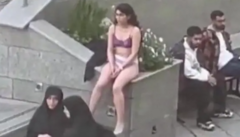
Iranian Authorities Decline to Charge Woman in Anti-Hijab Protest
An Iranian woman named Ahoo Daryaei will not face legal charges after stripping to her underwear in an apparent anti-hijab protest at a university in Tehran, according to Iranian judiciary officials. The incident, which occurred in November, drew significant international attention and condemnation.
The viral video showed Daryaei being forcibly detained after an altercation with security agents over her headscarf. Initially, Iranian authorities claimed she was “sick” and had been taken to a psychiatric ward – a tactic that has become increasingly familiar in dealing with women’s rights protesters.
Judiciary spokesman Asghar Jahangir stated that Daryaei was sent to the hospital, found to be ill, and subsequently handed over to her family without any judicial proceedings. This outcome came after widespread international pressure, including calls from Amnesty International for her immediate and unconditional release.
The incident highlights a broader pattern of how Iranian authorities handle women’s rights activists. Many protesters have been labeled as mentally ill as a means of discrediting their activism. Azam Jangravi, a woman who fled Iran to Canada in 2018, shared her experience of how the regime pressures families to declare women activists mentally unwell.
“My family didn’t do it, but many families under pressure do, thinking it’s the best way to protect their loved ones,” Jangravi explained. “This is how the Islamic Republic tries to discredit women, by questioning their mental health.”
The context of this protest stems from Iran’s mandatory hijab laws, which were implemented following the 1979 Islamic Revolution. Women are required to cover their hair and dress modestly, with significant consequences for non-compliance. This strict enforcement has been a source of ongoing tension and resistance.
The most notable recent example of this conflict was the death of Mahsa Amini, a Kurdish woman who died in police custody after being detained for allegedly not wearing her hijab “properly.” Her death sparked months of nationwide protests, during which more than 500 people were reportedly killed.
Daryaei’s protest and subsequent treatment represent a continuation of the ongoing struggle for women’s rights in Iran. By refusing to press charges and returning her to her family, authorities may be attempting to avoid further international scrutiny, though the underlying issues of women’s freedom and bodily autonomy remain unresolved.
The incident serves as a powerful reminder of the ongoing resistance against compulsory hijab laws and the creative ways Iranian women are challenging these restrictions. Social media and international attention have become crucial tools in bringing these protests to global awareness.
As women in Iran continue to challenge restrictive dress codes, the world watches and supports their fight for personal freedom and self-expression.









